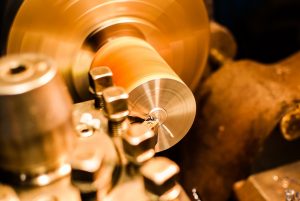
Milling operations can be classified as either face or peripheral, depending on where exactly the workpiece is cut. Both types involve the use of a rotating cutting tool, known as a milling cutter, to remove material from a workpiece. As the milling cutter rotates, it presses against the surface of the workpiece, essentially grinding away some of its material in that area.
Face milling and peripheral milling follow the same concept by using a rotating milling cutter to remove material from a workpiece. The way in which they perform this task, however, varies. So, what’s the difference between face milling and peripheral milling?
What Is Face Milling?
Face milling is a machining process in which the milling cutting is placed perpendicular to the workpiece. The milling cutting is essentially positioned “face down” towards the top of the workpiece. When engaged, the top of the milling cutting grinds away at the top of the workpiece to remove some of its material.
What Is Peripheral Milling?
Peripheral milling is a machining process in which the milling cutter is placed parallel to the workpiece. In other words, the milling cutter is positioned so that the sides of the cutter grind away at the top of the workpiece. This is in stark contrast to face milling in which the very tip of the cutter presses against the workpiece.
When compared to face milling, peripheral milling is more effective at removing large amounts of material from workpieces. This is because it uses the sides of the milling cutter rather than the tip. With face milling, only the tip of the cutter is exposed to the workpiece. While this fine for certain milling applications — particularly those that require a minimal amount of material to be removed — other applications require a deeper level of material removal. For milling applications such as this, peripheral milling is preferred. As the sides of the milling cutter rotate against the workpiece, it scoops out material from the workpiece, allowing it to remove more material than with face milling.
In Conclusion
Face milling and peripheral milling are the two primary types of milling operations. Both involve the use of a milling cutting that rotates while pressing against a workpiece to remove material from the workpiece. Face milling, however, positioned the milling cutter perpendicular to the workpiece, whereas peripheral milling places the cutter parallel to the workpiece. Of those two milling operations, peripheral milling is more effective for
